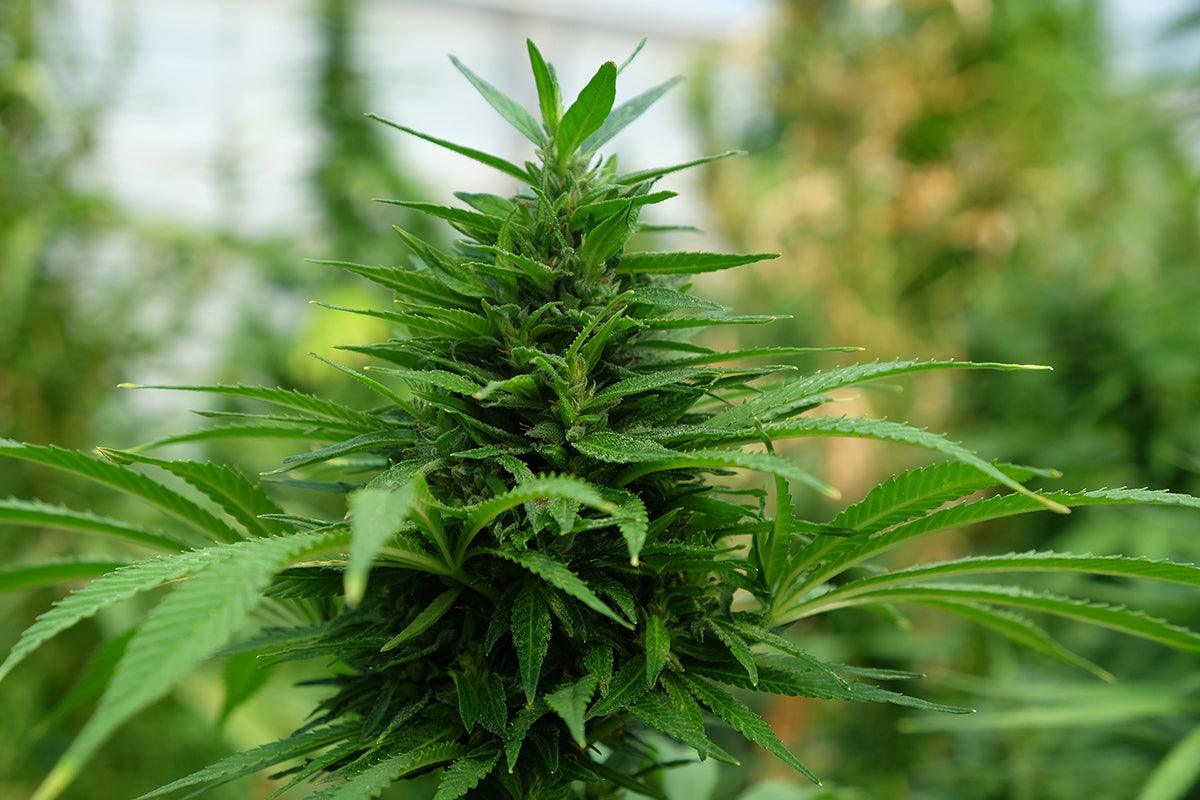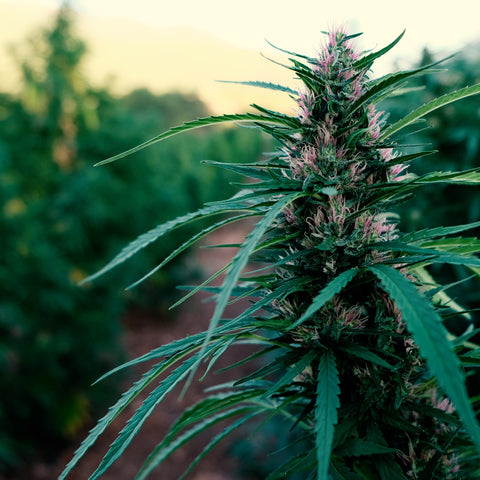Flavonoids constitute one of the most characteristic classes of compounds in higher plants. Many flavonoids are easily recognized as floral pigments in most angiosperms .
On the other hand, their distribution is not limited to the flowers, but includes all parts of the plant, in particular fruits and leaves.
- Cannabis flavonoids
- Flavonoids and terpenes
- What is the impact of flavonoids on humans?
- Flavonoids and ancient medicine
- The flavonoids most present in the cannabis plant
 Cannabis flavonoids
Cannabis flavonoids
Flavonoids are a large group of phytochemical compounds produced by the secondary metabolism of plants. They are produced by almost all plant species and have many functions.
The most curious and well-known ability of flavonoids is that of attracting pollinating insects through the color of the flowers, for which they themselves are responsible. Their name is linked precisely to their function as pigmentation of plants : flavonoid derives from the Latin "flavus" , which means yellow.
The beautiful colors of the flowers are not the only merit to be attributed to flavonoids: in many plants they play a protective role against parasites and fungi and, thanks to their ability to absorb light, they also act as a shield against ultraviolet rays .
Furthermore, some flavonoids are synthesized by the roots of plants and favor the proliferation of microorganisms capable of improving the exchange of nutrients with the soil and better fixing atmospheric nitrogen .
Finally, flavonoids also act at the plant cell level, regulating the cell cycle within the plant.
In fact, it is the largest family of nutrients currently known to modern science: over 5,000 different flavonoids have been identified in nature, all sharing the chemical structure of benzopyran from which various subclasses branch out.
In general, they belong to the large family of polyphenols and can be divided into eight main groups.
There are more than 5,000 known flavonoids and, at the moment, 23 are known to be present in cannabis. Of these, three are contained exclusively in cannabis: cannaflavin A, cannaflavin B and cannaflavin C.
They are present in branches and leaves and are particularly concentrated in flowers , while they are completely absent in seeds and roots ; it is estimated that approximately 2.5% of the dry weight of cannabis is due to flavonoids.
Plants are a riot of colors and it is often thought that it is all thanks to chlorophyll. In truth, chlorophyll is responsible for the only green pigment in plants, while flavonoids are responsible for all other pigments other than green .
For example, in some varieties of cannabis the inflorescences can take on purple and bluish colours, thanks to flavonoids called anthocyanins or anthocyanins .
Flavonoids and terpenes
Flavonoids and terpenes have a lot in common.
Terpenes are certainly the main ones responsible for the smell and flavor of cannabis, but they are often not alone: flavonoids contribute to defining the smell and flavor of cannabis inflorescences, as well as the color.
These molecules present in cannabis not only make the herb more seductive, but they also have several properties, such as filtering UV rays , protecting against fungi and parasites, and fixing nitrogen , all functions that are fundamental to the survival of cannabis.
It has been observed that flavonoids are able to modulate the effects of delta-9-tetrahydrocannabinol (THC) through a mechanism shared with cannabidiol (CBD) and some terpenes.
They are in fact able to act on certain enzymes (P450 3A11 and P450 3A4) and reduce the unwanted side effects of the psychoactive principle .
What is the impact of flavonoids on humans?
Research has not yet achieved great results on the possible benefits of cannabis flavonoids, mainly due to the limited resources allocated to the matter.
In any case, cannabis flavonoids have very interesting effects on human health. In addition to having a powerful antioxidant and anti-inflammatory action , they also have properties useful for the prevention and treatment of some pathological states.
Acting at the level of cytochromes, they modulate the absorption, distribution, metabolism and elimination of cannabinoids from the body .
Their beneficial properties on the human organism make them one of the most interesting aspects of therapeutic cannabis, even for pathologies that until now were little connected to this form of treatment.
Flavonoid deficiency is one of the evils of the century, complained by many dieticians and nutritionists , who are exploring different ways to change eating habits and integrate more flavonoids into a balanced diet.
Flavonoids and ancient medicine
Flavonoids belong to a group of phytonutrients called polyphenols.
In ancient Chinese and Ayurvedic medicines, polyphenols were commonly used to promote skin protection, brain function, normal blood sugar levels and correct blood pressure .
Polyphenols were also known for their anti-inflammatory and antioxidant properties.
It is believed that many flavonoids are concentrated in the peel of fruit and vegetables, but - being very fragile compounds - they tend to be eliminated from most cooking procedures. The advice of nutritionists and dieticians is to consume plenty of raw fruit and vegetables, in which the flavonoids are not dispersed.
Thanks to their multiple properties, research indicates that flavonoids can positively influence:
- Longevity
- Weight control
- Cardiovascular diseases
- Diabetes
- Neurodegeneration
The flavonoids most present in the cannabis plant
As many as 23 flavonoids present in the cannabis plant have been identified.
Of these, three are contained exclusively in cannabis and are known by the names cannaflavin A – B and C. Below, a list of the most famous and useful flavonoids present in marijuana.
Apigenin
It is a flavonoid present in almost all vascular plants which are associated with antioxidant, anti-inflammatory and anxiolytic properties.
Its biological activity lies in the ability to bind effectively to some receptors present on cells . Apigenin is able to bind to some hormone receptors preventing the accumulation of hormones , with the result that it can slow down the growth of breast cancer by limiting the presence of the hormone estradiol.
Furthermore, the ability of this molecule to selectively bind to benzodiazepine receptors makes it a powerful natural anxiolytic, preferable to synthetic anxiolytics, due to their known side effects, such as muscle relaxation, amnesia, and sedation.
Cannaflavin A and B
They are two flavonoids present exclusively in the cannabis plant and act as powerful anti-inflammatories.
It has been estimated that they can reduce inflammation 30 times more effectively than aspirin. They inhibit the production of prostaglandin E2 and 5-lipoxygenase, natural inflammatory agents of the body and mediators of asthmatic inflammation which are calmed in the presence of cannaflavins.
It is believed, however, that this anti-inflammatory power is not all thanks to the flavonoids, but is due to a synergy between the latter, terpenoids and cannabinoids.
Kaempferol
It is a flavone that shares antioxidant and anti-carcinogenic properties with apigenin : in fact, it seems that a diet rich in kaempferol can reduce the risk of cancer and some coronary heart diseases.
Some studies show that it can be useful as a natural antidepressant and that it can act in synergy with some cannabinoids.
Quercetin
It is a flavonol present in almost all vascular plants, and boasts many pharmaceutical properties. Given the presence of 5 hydroxyl groups (-OH) and a carbonyl group (-CO), quercetin is an extremely powerful antioxidant .
Its ability to inhibit viral enzymes allows it to act as an antiviral. Given the ability to inhibit the formation of prostaglandin E2 and 5-lipoxygenase, a mechanism shared with cannaflavins A and B, it is also able to act as an anti-inflammatory.
Beta-sitosterol
Beta-sitosterol is actually a phytosterol, that is, a plant sterol, found in fruit, vegetables, nuts and seeds.
According to the Food and Drug Administration (USA) foods that contain beta-sitosterol are able to reduce the risks of coronary heart disease , thanks to the reduction of cholesterol levels in the blood .
Additionally, beta-sitosterol is widely used medicinally in topical ointments for cuts and burns and in the prevention of colon cancer .
If the article was of interest to you, share it on social media with the rest of the Community, every single share helps us support our blog and keep you 360° informed on the world of Cannabis.








